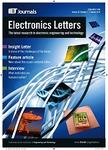版权所有:内蒙古大学图书馆 技术提供:维普资讯• 智图
内蒙古自治区呼和浩特市赛罕区大学西街235号 邮编: 010021

作者机构:Univ Maryland Percept & Robot Grp College Pk MD 20742 USA
出 版 物:《ELECTRONICS LETTERS》 (电子学快报)
年 卷 期:2021年第57卷第16期
页 面:614-617页
核心收录:
学科分类:0808[工学-电气工程] 0809[工学-电子科学与技术(可授工学、理学学位)] 08[工学]
基 金:Brin Family Foundation Northrop Grumman Mission Systems University Research Program ONR [N00014-17-1-2622] National Science Foundation [BCS 1824198]
主 题:Optical, image and video signal processing Image recognition Optimisation techniques Spatial variables control Transducers and sensing devices Aerospace control Mobile robots Telerobotics Sensor fusion Computer vision and image processing techniques File organisation Control engineering computing Optimisation techniques Other topics in statistics
摘 要:Global optical flow estimation is the foundation stone for obtaining odometry which is used to enable aerial robot navigation. However, such a method has to be of low latency and high robustness whilst also respecting the size, weight, area and power (SWAP) constraints of the robot. A combination of cameras coupled with inertial measurement units (IMUs) has proven to be the best combination in order to obtain such low latency odometry on resource-constrained aerial robots. Recently, deep learning approaches for visual inertial fusion have gained momentum due to their high accuracy and robustness. However, an equally noteworthy benefit for robotics of these techniques are their inherent scalability (adaptation to different sized aerial robots) and unification (same method works on different sized aerial robots). To this end, we present a deep learning approach called PRGFlow for obtaining global optical flow and then loosely fuse it with an IMU for full 6-DoF (Degrees of Freedom) relative pose estimation (which is then integrated to obtain odometry). The network is evaluated on the MSCOCO dataset and the dead-reckoned odometry on multiple real-flight trajectories without any fine-tuning or re-training. A detailed benchmark comparing different network architectures and loss functions to enable scalability is also presented. It is shown that the method outperforms classical feature matching methods by 2x under noisy data. The supplementary material and code can be found at .